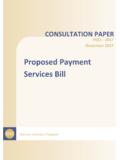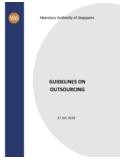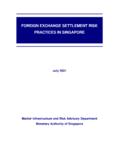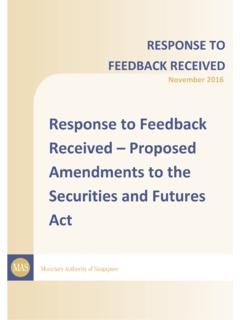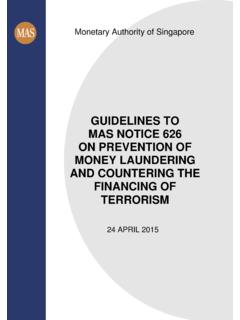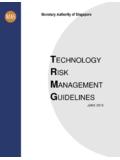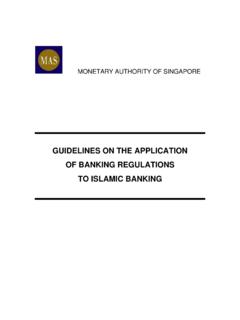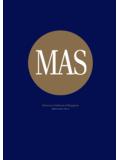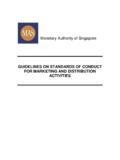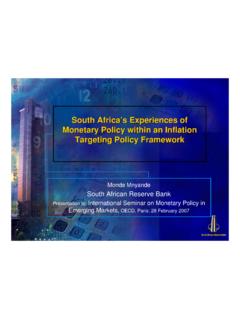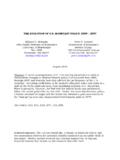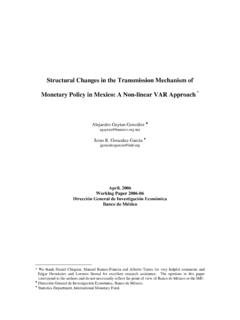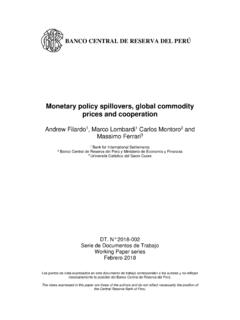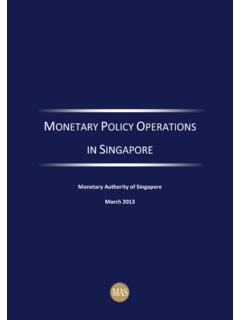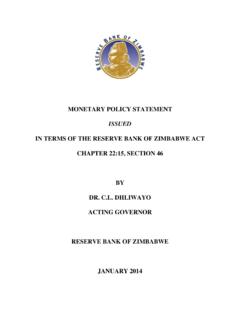Transcription of Risk-based Capital Framework For Insurance Business
1 CONSULTATION PAPER14 - 2003 November 2003 Risk-based CapitalFramework For Insurance BusinessConsultation Paper on the Proposed Risk-based Capital Framework for Insurance Business Nov 2003 monetary Authority of Singapore i EXECUTIVE SUMMARY Insurance companies are facing greater challenges in their businesses, particularly in terms of volatility of assets and diversity of Insurance risks, as well as keener competition from other financial institutions. While the existing statutory solvency Framework , which relies on undisclosed margins and approximations, has served its purpose well, it is not sufficiently transparent or risk-focused to adequately reflect the true financial conditions of the Insurance companies in the new environment. To address these inadequacies, the Authority proposes to adopt a Risk-based Capital (RBC) Framework , which was formulated in close consultation with Insurance practitioners and representatives from the actuarial and accounting professions.
2 The proposed Framework , based on emerging international standards and good practices in developed countries, is risk-focused. It reflects the relevant risks that the Insurance companies face. The minimum Capital prescribed under the Framework , which includes a consistent approach to the valuation of assets and liabilities, will serve as an effective buffer to absorb losses. With greater transparency, it will facilitate comparisons across Insurance companies. It will also provide clearer information on the financial strength of insurers, and facilitate early and effective intervention by the Authority, if necessary. Under the new Framework , the requirements have been aligned across financial institutions as far as possible, so as to minimize Capital arbitrage in an increasingly integrated financial landscape. In May 2003, the Authority issued a consultation paper on the proposed amendments to the Insurance Act required to establish the new RBC Framework .
3 The Authority has considered the feedback received during that consultation phase carefully, and made necessary changes to the Insurance (Amendment) Bill 2003. This consultation paper seeks to obtain feedback on operational details, and the draft regulations, notice and guidelines relating to the new RBC Framework for Insurance companies. Consultation Paper on the Proposed Risk-based Capital Framework for Insurance Business Nov 2003 monetary Authority of Singapore ii TABLE OF CONTENTS Executive Table of 1 2 Valuation of Assets and Valuation of Valuation of 3 Operations of the Participating The Surplus Account and policy liability of participating Bonus 4 Fund Solvency Requirement and Capital Adequacy Components of the Capital Fund Solvency Capital Adequacy Some further 5 Reporting 6 Transitional Reporting Capital 7 Insurance Regulations and 8 Request for Annex 1: Draft Insurance (Valuation and Capital ) Regulations Annex 2: Draft Insurance (Accounts and Statements) Regulations Annex 3: Draft Insurance (Actuaries) Regulations Annex 4: Draft Notice on the Valuation of Policy Liabilities of Life Business Annex 5.
4 Draft Guidelines on the Valuation of Policy Liabilities for General Business Consultation Paper on the Proposed Risk-based Capital Framework for Insurance Business Nov 2003 monetary Authority of Singapore 1 1 BACKGROUND While the existing statutory solvency Framework , which relies on undisclosed margins and approximations, has served its purpose well, it is not sufficiently transparent or risk-focused to adequately reflect the true financial conditions of Insurance companies in the new environment. With the financial services sector becoming increasingly volatile, diverse and competitive, there is a need for a more transparent and risk-focused regime. The Authority has therefore proposed to adopt a Risk-based Capital (RBC) Framework . This new Framework seeks to amend the existing valuation methodology for assets and liabilities, fine-tune the operations of life Insurance funds, establish new Capital requirement rules, update the role of actuaries, and introduce a new set of statutory reporting standards.
5 The Authority has been working closely with the Insurance industry in formulating the proposed RBC Framework . Following the announcement of the RBC concept in the 2001 exposure draft, work groups consisting of Insurance practitioners and representatives from the actuarial and accounting professions were formed to look into various valuation and Capital treatment issues. The work groups issued 3 discussion papers between July 2001 to December 2002 on the valuation of assets and liabilities, Capital requirements for life Insurance Business , and Capital requirements for general Insurance Business . The Authority has also engaged Insurance companies in carrying out tests on the proposed Framework since mid-2002. Draft amendments to the Insurance Act (IA) necessary to establish the RBC Framework were released for consultation in May 2003.
6 Careful consideration was given to the feedback received during that consultation phase. Necessary changes were subsequently made to the Insurance (Amendment) Bill. This consultation paper will describe, and seek the public s feedback on, the significant features of the new RBC Framework and the regulations, notice and guidelines created for this Framework . 2 VALUATION OF ASSETS AND LIABILITIES Consultation Paper on the Proposed Risk-based Capital Framework for Insurance Business Nov 2003 monetary Authority of Singapore 2 Before we discuss the amount of Capital requirements for an insurer, we need to first determine the value of its assets and liabilities. The proposed valuation regime makes a fundamental shift away from the current philosophy, which is built upon estimations of asset and liability values with undisclosed margins and approximations, to one that emphasizes greater transparency and provides a more accurate picture of the insurer s financial position.
7 This is achieved by using more realistic valuation methodology and bases. More assumptions will need to be made in the valuation process. This shift will inevitably place greater reliance on the professional judgement of actuaries and accountants. The Authority will therefore continue to work closely with the two professions to fine-tune the valuation standards in relation to Insurance Business . We will now highlight some of the key features of the proposed assets and liabilities valuation rules. Details of the rules can be found in the draft regulations, notice and guidelines in the Annexes 1, 4 and 5. Valuation of assets The lower of book or market rule used currently in asset valuation usually does not portray an insurer s true financial strength. To arrive at a realistic valuation, the proposed asset valuation rules will need to adopt the market values of assets.
8 In addition, all assets of an insurer will be reflected in its balance sheet. Issues relating to eligibility of assets such as over-concentration in certain type of assets, or excessive exposure to certain counter-parties, will be dealt with in the Capital requirement rules instead. Valuation of liabilities The Authority made its first move to a more realistic valuation of Insurance liabilities in 2001 when it imposed new valuation requirements on the general Insurance sector. General insurers are required to determine best estimates (BE) of their Insurance liabilities, and additional provisions for adverse deviation (PAD) that reach at least the 75% level of sufficiency. The requirements apply to both the risks related to Insurance services that have yet to be provided (the premium liabilities ) and claims that have been incurred but not yet settled as at valuation date (the claims liabilities ).
9 Consultation Paper on the Proposed Risk-based Capital Framework for Insurance Business Nov 2003 monetary Authority of Singapore 3 We propose to extend the new valuation requirements of Insurance liabilities to life Insurance Business . The net premium valuation method using prescriptive valuation assumptions will be replaced. In its place, insurers will determine BE, and additional PAD. The BE shall be determined by first projecting future cash flows using realistic assumptions (including assumptions on expenses, mortality and morbidity rates, lapse rates, etc.), and then discounting these cash flow streams at appropriate interest rates. PAD is determined by using more conservative assumptions in the projection to reflect the inherent uncertainty of the BE. The policy liability for any policy (be it a participating policy, a non-participating policy or an investment-linked policy) will simply be the sum of its BE and PAD.
10 For participating policies, policy liability should include provision for future payments arising from both guaranteed and non-guaranteed benefits. The policy liability of a life Insurance fund made up solely of non-participating or investment-linked policies is calculated by aggregating the policy liabilities of all policies in the fund. On the other hand, for a life Insurance fund that consists of participating policies (or more commonly know as the participating fund), the policy liability of the fund is derived not only by aggregating the policy liabilities of all policies in the fund, but is also dependent on the value of assets backing the liabilities and the extent to which benefits are guaranteed. This is best discussed in conjunction with changes proposed on the operations of the participating fund.
